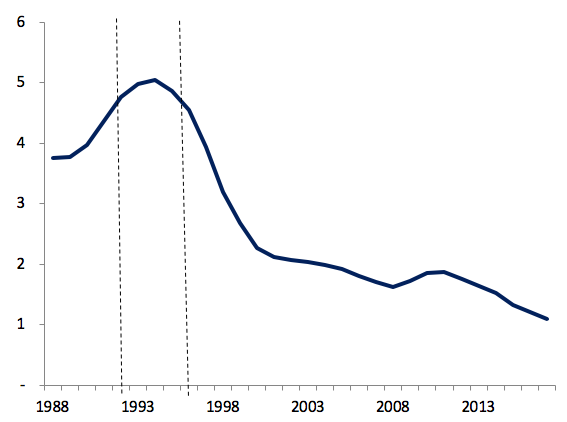Welfare Reform in the US: Effects On Female Crime And Civic Participation
Sunday 09 September, 2018 Written by Hope Corman, Dhaval Dave, Nancy Reichman
The 1996 welfare reform in the US was a major policy shift that sought to reduce dependence of single parents on government benefits by promoting work, encouraging marriage, and reducing non-marital childbearing. This column describes how the reform led to a decline in illicit drug use among women at risk of relying on welfare, a decrease in female arrests for property crime, and smaller declines in voting for women exposed to the reform compared to several similar comparison groups. The findings offer evidence that limiting cash assistance and encouraging work can lead to reductions in socially undesirable behaviours and increases in prosocial community behaviours.
The US Personal Responsibility and Work Opportunity Reconciliation Act (PRWORA) of 1996, often referred to as ‘welfare reform’, was a major policy shift in the US that sought to dramatically reduce dependence of single parents on government benefits by promoting work, encouraging marriage, and reducing non-marital childbearing. The legislation represented a convergence of dissatisfaction with the welfare system on both sides of the political spectrum, with welfare participation becoming viewed by many as a cause of dependence rather than a consequence of disadvantage.
The key strategy for reducing dependence was to promote employment by imposing work requirements as a condition for receiving benefits in concert with a lifetime limit on receipt of cash assistance. The basic argument was that labour force participation would break a culture of dependence by increasing self-sufficiency and reconnecting members of an increasingly marginalised underclass to the mainstream ideals of a strong work ethic and civic responsibility (Katz 2001). At the same time, there were concerns that some individuals would be ill equipped to maintain stable employment (due to low job skills or disability, for example) and that the pro-work regime would marginalise, rather than mainstream, those individuals by contributing to existing hardships (Lichter and Jayakody 2002).
States were granted considerable latitude in setting welfare benefit generosity levels and specifying other aspects of their welfare programmes subject to new national guidelines under PRWORA that mandated work requirements and a five-year lifetime limit on the receipt of cash assistance. Although welfare reform is often dated to the PRWORA legislation, reforms started taking place in the early 1990s, when the Clinton administration greatly expanded the use and scope of ‘welfare waivers’ to allow states to carry out experimental changes to their welfare programmes. Many of the features of these pre-PRWORA programmes, such as work requirements and time limits, were adopted as part of the 1996 legislation.
The reforms have been successful in that welfare caseloads have declined dramatically – 78% since their peak in 1994 (see Figure 1). Employment of low-skilled women also increased in the aftermath of the reforms and at least some of the increases can be attributed to welfare reform (Fang and Keane 2004, Ziliak 2016). Effects on marriage, cohabitation, and non-marital fertility were mixed or weak (e.g. Grogger and Karoly 2005). Until recently, the success of the ‘work first’ strategy had been little explored with respect to other important indicators of mainstream or marginal behaviour that could serve to more broadly test the ‘culture of poverty’ argument upon which welfare reform was predicated. One such behaviour is female crime, which has been increasing both in absolute terms and relative to men (Campagniello 2014). Another is voting, which is an important form of civic participation in democratic societies but a fundamental right that many citizens do not exercise.
Figure 1 Average monthly family welfare caseloads (millions of cases), US, fiscal years 1988-2017

Notes: Dashed vertical lines indicate when pre-PRWORA reforms started (Oct. 1992) and enactment of the federal PRWORA legislation took place (Aug. 1996)
Data source: https://www.acf.hhs.gov/ofa/programs/tanf/data-reports
In a series of recent papers, we investigated the effects of welfare reform in the US – which is still in effect today – on women’s illicit drug use and other types of crime, as well as on voting.
Impact on women's illicit drug use
In Corman et al. (2013), we exploited changes in welfare policy across states and over time and compared relevant population subgroups within an econometric difference-in-differences framework to estimate the effects of welfare reform on adult women’s illicit drug use from 1992 to 2002. The analyses were based on all available and appropriate national data sets, each offering unique strengths and measuring a different drug-related outcome (self-reported illicit drug use, drug-related prison admissions, drug-related arrests, and drug-related emergency department episodes). We found robust evidence that welfare reform led to a 10%–21% decline in illicit drug use among women at risk of relying on welfare, as well as associated declines in drug-related arrests (6%–7%), drug-related hospital emergency department episodes (7%–11%), and possibly drug-related prison admissions (11%–19%). These findings provide some support of the ‘mainstreaming’ argument underlying welfare reform.
Impact on crime
In Corman et al. (2014), we considered crime more broadly, focusing on arrests. Specifically, we exploited changes in the implementation of welfare reform across states and over time in a difference-in-differences framework to estimate causal effects of welfare reform on adult women’s arrests from 1992 to 2002, using monthly state-level data on arrest rates compiled by the FBI. We found that welfare reform led to decreases in female arrests for property crime – which is the type of crime women are most likely to commit (Campagniello 2014) – by 4–5%, but did not affect arrests for other types of non-drug related crime. The effects appeared to have been stronger in states with larger welfare caseload declines. As welfare reform policies are targeted to females, it was empirically validating that we did not find any substantively or statistically significant effects of welfare reform on crime among males. The findings from this study point to broad-based work incentives – and, by inference, employment – as an important determinant of female property crime and, together with those from Corman et al. (2013), provide support for the ‘mainstreaming’ argument that served as a basis for the enactment of welfare reform.
In Corman et al. (2018), we extended this work by exploring age-patterning of the effects of welfare reform on women’s property crime arrests, as well as the extent to which specific state-level welfare and criminal justice policies shaped that patterning. We found that:
- women’s property crime arrest rates declined over the age span,
- welfare reform led to an overall reduction in adult women’s property crime arrests of about 4% with the strongest effects for women ages 25–29 and women in their 40s,
- the effects were slightly stronger in states with stricter work incentives in their welfare programmes, and
- the effects were much stronger in states with high levels of per capita criminal justice expenditures and staffing for all age cohorts.
These findings suggest that welfare reform has conferred societal benefits in terms of a reduction in female property crime that is not only likely to persist (because welfare reform is currently very much in effect today), but is also likely to compound in the future (owing to strong effects for relatively young women). These findings also add to the general understanding of the effects of ‘turning points’ – life events or noteworthy changes in circumstances – on criminal careers.
Impact on women's civic participation
Finally, in Corman et al. (2017), we investigated the effects of welfare reform on women’s voting registration and voting participation in a difference-in-differences framework using the November Current Population Surveys with the added Voting and Registration Supplement for the years 1990 through 2004 – a time period enveloping welfare reform and in which voter turnout was declining in the US. We found robust evidence that welfare reform led to smaller declines in voting (about 10% smaller) for women who were exposed to welfare reform compared to several different comparison groups of similar women who were much less exposed. The effects were largely confined to presidential elections, were stronger in Democratic than Republican states, were stronger in states with stronger work incentive policies, and appeared to operate through employment, education, and income. These findings, that welfare reform had prosocial effects on civic participation as characterized by voting, again support the premise behind the enactment of welfare reform that restricting cash assistance and encouraging work would bring single mothers from the margins to the mainstream. More generally, the findings contribute strong evidence about effects of work incentives, and by inference, employment or income, on political participation.
Concluding remarks
Overall, the findings from our research on the effects of US welfare reform are consistent with the argument that limiting cash assistance and encouraging work would lead to reductions in socially undesirable behaviours and increases in prosocial community behaviours. As such, these findings support the culture of poverty arguments that gave rise to the legislation. That said, we were limited in our ability to explore heterogeneity within these average effects by characteristics of mothers such as mental and physical disability; it is important to delve more deeply to identify subgroups that were potentially harmed by the legislation. In addition, the implementation of welfare reform occurred within the context of a strong economy and it is important to explore the effects of welfare policies in other economic contexts such as the Great Recession. Finally, more research is needed on other pro- and anti-social behaviours, longer-term effects, and potential spillover effects to other family members to gain a more complete picture of the full effects of the large and ongoing social experiment known as welfare reform.

Image: Dhaval Dave Stanton Research Professor in Economics, Bentley University

Image: Nancy Reichman Professor of Pediatrics, Robert Wood Johnson Medical School, Rutgers University
References
Campagniello, N (2014), “Women in Crime”, IZA World of Labor: 105.
Corman, H, D M Dave, N E Reichman (2014), “Effects of Welfare Reform on Women's Crime”, International Review of Law and Economics 40: 1–14.
Corman, H, D M Dave, N E Reichman (2017), “Effects of Welfare Reform on Women's Voting Participation”, Economic Inquiry 55(3): 1430–1451.
Corman, H, D M Dave, and N E Reichman (2018), “Age Gradient in Female Crime: Welfare Reform as a Turning Point”, NBER Working paper No. 24464.
Corman, H, D M Dave, N E Reichman and D Das (2013), “Effects of Welfare Reform on Illicit Drug Use of Adult Women”, Economic Inquiry 51: 653–674.
Fang, H and M Keane (2004), “Assessing the Impact of Welfare Reform on Single Mothers”, Brookings Papers on Economic Activity.
Grogger, J and L A Karoly (2005), Welfare Reform: Effects of a Decade of Change, Harvard University Press.
Katz, M B (2001), The Price of Citizenship: Redefining the American Welfare State, Metropolitan Books, Henry Holt & Co.
Lichter, D T and R Jayakody (2002), “Welfare Reform: How Do We Measure Success?” Annual Review of Sociology 28: 117-41.
Ziliak, J P (2016), “Temporary Assistance for Needy Families”, in R A Moffitt, (ed.), Economics of Means-Tested Transfer Programs in the United States, Volume 1, University of Chicago Press: 303–393.
ABC Comment: Have your say below:

Leave a comment
Make sure you enter all the required information, indicated by an asterisk (*). HTML code is not allowed.
Join
FREE
Here










